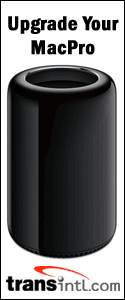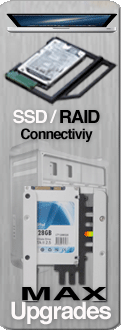
SHOOTOUT: Originally posted April 10th, 2007 by rob-ART
morgan, mad scientist Our 8-core (dual quad-core) Mac Pro arrived ahead of schedule. We stayed up late last night testing it against the 4-core (dual dual-core) Mac Pro running at the same clock speed (3GHz). We used the same 8 memory modules (total of 16GB) and identical models of hard drive. The 8-core had the Quadro FX 4500 graphics card while the 4-core had the Radeon X1900 XT, but this first round of testing is strictly CPU intensive. Cinebench 9.5 UB used all 8-cores, dramatically illustrating it during the CPU render. As you can see from the screen dump below, it was rendering 8 different parts of the model simultaneously and registering 798% usage by Activity Monitor. However, when we compared the CB rating with the 4-core Mac Pro, the 8-core was only 45% faster. Geekbench, on the other hand, registered up to 600% CPU usage on the 8-core. The resulting rating was 56% faster than the 4-core. EIGHT-CORE - NO ADVANTAGE WITH PHOTOSHOP and APERTURE A bit depressing when the Activity Monitor registers 796% CPU usage on the 8-core versus 395% usage on the 4-core, yet the total time to complete the task is only 0% faster in the case of Photoshop CS3 and only 7% faster in the case of Aperture. Some of you are asking about the Quad G5. I included it in the 3 graphs above in case you are wondering how it compares to the Mac Pros when running the latest "UB pro" software. EIGHT-CORE -- A DIFFERENT WITH AFTER EFFECTS CS3 We decided to experiment with this feature using the TotalBenchmark project by Brian Maffitt. See our Special Report on After Effects CS3. SPINNING MORE PLATES HardMac did a similar test back in February when they upgraded their Mac Pro to 8-cores. MORE SPEED TESTING OF THE 8-core Special Report on After Effects CS3 running on the Mac Pros, G5 Quad, and MacBook Pro. Multi-Processing (Simultaneous rendering by Final Cut Pro, Motion, iDVD, and Photoshop CS3) 3D Gaming (Quake 4, Doom 3, Unreal Tournament 2004, Halo, World of Warcraft, Prey) using three different graphics cards MEMORY BOTTLENECK? We did run the "test-compute-speed" with digLloydTools (DLT) on the 8-core. Its aggregate rate was 1204MB/sec (versus the 4-core's 601MB/s). That says that if the task is pure CPU, the 8-core is twice as fast as the 4-core. But if your task has to do a lot of interaction with memory, the advantage drops almost to nothing -- as we saw with Photoshop CS3 and Aperture. TIGER IS "CHASING ITS TAIL" On the other hand, there are scenarios where the 8-core Mac Pro will be able to show its multi-threading muscle, as exemplified by the QuickTime graph above. OUR CONCLUSION FROM TEST RESULTS ON THIS PAGE (and others) And if you perform multiple tasks within an application (like our QuickTime simultaneous conversion test above) or have multiple apps active (like in our Multi-Processing page), then you are a candidate for an 8-core Mac Pro. SPECIAL MEMORY AND DRIVES FOR THE 8-core? We have tested OWC and TransIntl memory on our 8-core. And those companies have confirmed that their memory is fully compatible with the 8-core. NO, the heatsink has not been altered on Apple's factory "8-core compatible" memory. It's identical those shipped with the 4-core Mac Pro. As for the reference to compatible drive kits, Apple's bulletin makes absolutely no sense. And, NO, the sled design has not been altered on the 8-core, as some have claimed. We took a retail Seagate 7200.10 750G, for example, and installed it on one of the sleds. We formatted it and installed OS X from the DVDs that come with the 8-core. Works like a charm. Ditto for a retail Maxtor MaXLine Pro 500. Don't let this bulletin scare you into paying "luxury" prices for Apple memory and hard drive upgrade kits. WHERE TO BUY THE EIGHT-CORE MAC PRO You can also purchase Apple systems and accessories from Small Dog Electronics. You can configure-to-order through them just like on the Apple Store. WHERE TO BUY MEMORY FOR YOUR 8-CORE MAC PRO We have tested both 2GB and 1GB modules from Other World Computing in our 8-core Mac Pro. They offer a "Trade In Your Factory Memory" REBATE program. TransIntl.com designed their own heat sinks with 6 cooling fins on each side (versus 4 on the Apple factory modules) using a special aluminum alloy. We have tested their 1GB and 2GB and 4GB modules in our 8-core Mac Pro. We have tested MaxUpgrades' memory in our 4-core. They assured us that they have tested their memory on their 8-core Mac Pro without any errors and crashes. They also sell their heat sinks separately as well as a memory cooling kit called "max_flo." WHAT GRAPHICS CARD SHOULD YOU BUY FOR THE 8-CORE or 4-CORE? Has Bare Feats helped you? How about helping Bare Feats? © 1995 - 2007 Rob Art Morgan
8-core Mac Pro versus
4-core Mac Pro
On April 29th, 2007, more After Effects CS3 Results Added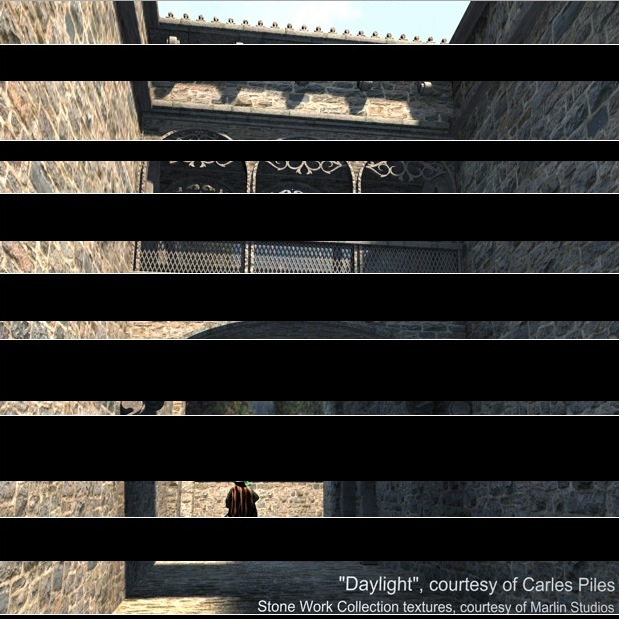
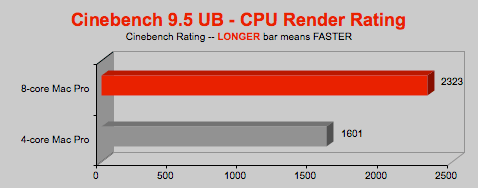
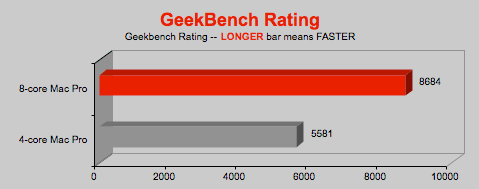
When we ran Photoshop CS3 and Aperture 1.5, Activity Monitor showed all 8-cores cranking (up to 796% usage) but the total time to complete the task was barely faster than with the 4-core Mac Pro. Check it out: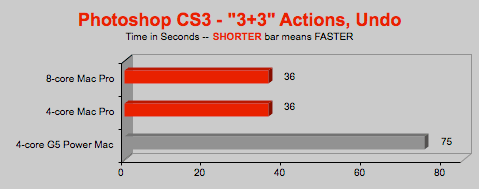
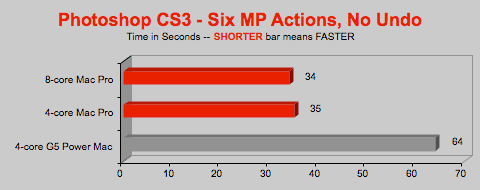
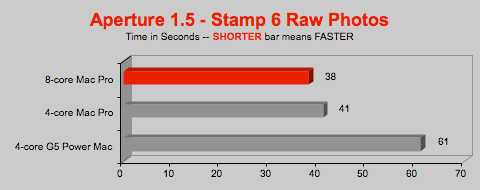
The 8-core Mac Pro showed more muscle when we ran After Effects CS3 beta. After Effects CS3 has an item in Preferences called "Multiprocessing." It has a check box that enables "render multiple frames simultaneously." When checked, AE spawned a process for each core called "aeselflink" and grabbed 1.6GB of real memory per process. It was like creating a "render farm" within one Mac.
The gains with a single QuickTime Export and and single iDVD Video Asset Encode were non-existent. But... then we opened six copies of the same HD sample 2 minute movie in QuickTime Player 7.1.5. Then we simultaneously converted all six clips to iPod movie format. The 8-core completed the task 38% faster than the 4-core Mac Pro: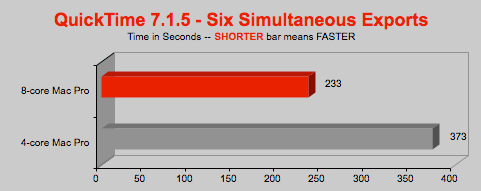
In addition to this article, we have...
Our friend, Lloyd Chambers, thinks there's a memory bus bottleneck for the 8-core, which he discussed back in March on his blog. He wrote, "Memory bandwidth is inadequate for 8-cores. It’s already a limiting factor with the current quad-core 3.0 GHz Mac Pro. Memory copy speed is at best 2.9GB/sec on the Mac Pro, in spite of Apple’s highly misleading claims of 21.3 GB/sec (“maximum processor bandwidth of up to 21.3 GB/s”—bandwidth is a bit more than double the memory copy speed). That’s a measly 700MB/sec per core on a quad-core machine, and only 350MB/sec per core on an octa-core machine. By comparison, a 6-drive hard disk RAID array can easily perform at over 400MB/sec!"
"Yes, the memory bus is weak, but the biggest problem is that OS 10.4 (Tiger) does not know how to deal with so many cores. Perhaps 10.5 (Leopard) will. the problem is that the OS does not know that it should keep a thread on the SAME core instead of swapping it around to any one of the 8-cores. When a thread moves to a different core-group, the cache has to be reloaded on the new core. Since Intel quad-cores are two Core 2 Duos "duct-taped" together, the problem is worse than it would otherwise have been. When this thread/core shift happens repeatedly, it makes the cache ineffective and floods the memory bus with activity." (Though put forth by an anonymous BF reader, this analysis has been confirmed by Lloyd Chambers where he discussed "core swapping" on his latest blog entries regarding the 8-core Mac Pro.)
In spite of the limitations posed by the memory bus and OS X "Tiger's" handling of core swapping, there are things that the 8-core Mac Pro does signficantly faster than the 4-core Mac Pro. If you are using After Effects CS3 (or any app like it that knows how to use all 8 cores effectively), the 8-core is worth the extra money, in our opinion.
Meanwhile, we are intrigued by the tech note on Apple's site specifying that only certain memory kits and hard drive kits they sell are compatible with the 8-core Mac Pro. One memory maker informed us that Apple was using more than one source for the Advanced Memory Buffer (AMB) chip for the 4-core Mac Pro. Now they are using only one particular AMB which complies with stricter specifications.
If you live in the USA and plan to purchase an APPLE product, please CLICK THIS LINK or any APPLE DISPLAY AD to help us earn our affiliate commission. It's a great way to support Bare Feats.
We have tested the memory from the following companies in our 8-core Mac Pro and can recommend them to you....
FYI, The Quadro FX 4500 messes up in Maya 8.5. According to the Alias/Autodesk engineering support "qualified hardware" page, the FX 4500 (and GeForce 7300 GT) fails to render shadows properly in the Hardware Renderer and in the High Quality Viewport. However, there are no problems with the Radeon X1900 XT. That's ironic when you consider that Apple promotes the FX 4500 as the "ideal choice for high-end scientific visualization." Unless you do 3D stereo-in-a-window, we recommend the much-more-affordable Radeon X1900 XT.
"BARE facts on Macintosh speed FEATS"
Email
, the webmaster and mad scientist
